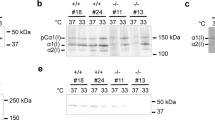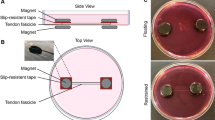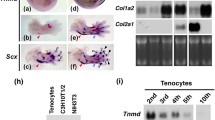Abstract.
Heat shock protein 47 (Hsp47) is a collagen-binding stress protein that acts as a collagen-specific molecular chaperone during the biosynthesis and secretion of procollagen. Type I collagen is a major component of tendons. Coexpression of genes for both proteins has been reported in various tissues, where many growth factors likely regulate their expressions in different ways. Here we describe the effects of increased temperature, mechanical stress and growth factors on Hsp47 and type I procollagen expression in embryonic chicken tendon cells. The expression of Hsp47 mRNA at 45°C increased within 60 min and returned to baseline in 4 h after the temperature decreased to 37°C. Our data also show that transforming growth factor β1 (TGF-β1) is another regulator of Hsp47 expression as the addition of TGF-β1 led to a moderate increase in the expression of Hsp47 mRNA. TGF-β2 and TGF-β3 exerted only a small effect; epidermal growth factor and tumor necrosis factor α (TNF-α) had none. TGF-β1 increased type I procollagen mRNA expression and TNF-α reduced this expression. TGF-β1 delayed the degradation of Hsp47 mRNA after heat shock likely via post-transcriptional regulation of the Hsp47 gene. We also report that mechanical stress increased Hsp47 mRNA expression and Hsp47 protein synthesis. Induction of Hsp47 protein expression by heat shock, mechanical stress and TGF-β1 was likely achieved through activation and translocation of heat shock transcription factor 1 into the nucleus. Our data indicate that TGF-β1 is a major regulator of both procollagen and Hsp47 genes.









Similar content being viewed by others
References
Amara FM, Chen FY, Wright JA (1995) Defining a novel cis element in the 3'-untranslated region of mammalian ribonucleotide reductase component R2 mRNA: role in transforming growth factor-beta 1 induced mRNA stabilization. Nucleic Acids Res 23:14610–1467
Alberts B, Bray D, Lewis J, Raff M, Roberts K, Watson JD (1994) The extracellular matrix of animals. In: Molecular biology of the cell, 3rd edn. Garland Publishing, New York, pp 971–999
Baler R, Dahl G, Voellmy R (1993) Activation of human heat shock genes is accompanied by oligomerization, modification, and rapid translocation of heat shock transcription factor HSF1. Mol Cell Biol 13:2486–2496
Childs CB, Proper JA, Tucker RF, Moses HL (1982) Serum contains a platelet-derived transforming growth factor. Proc Natl Acad Sci U S A 79:5312–536
Chong IW, Lin SR, Hwang JJ, Huang MS, Wang TH, Tsai MS, Hou JJ, Paulauskis JD (2000) Expression and regulation of macrophage inflammatory protein-2 gene by vanadium in mouse macrophages. Inflammation 24:127–139
Clarke EP, Jain N, Brickenden A, Lorimer IA, Sanwal BD (1993) Parallel regulation of procollagen I and colligin, a collagen-binding protein and a member of the serine protease inhibitor family. J Cell Biol 121:193–199
Derynck R, Lindquist PB, Lee A, In D, Tamn J, Graycar JL, Rhee L, Mason AJ, Miller DA, Coffey RJ, Moses HL, Chen EY (1988) A new type of transforming growth factor-beta, TGF-beta 3. EMBO J 7:3737–3743
Halper J, Hu W, Kisaalita WS, Griffin A, Rowland GN (2000) Immunohistochemical detection of fibrillar collagens in tissue sections and in cultured cells. J Histotechnol 23:333–336
Harrison P, Bradley L, Bomford A (2000) Mechanism of regulation of HGF/SF gene expression in fibroblasts by TGF-β1. Biochem Biophys Res Commun 271:203–211
Heimark RL, Twardzik DR, Schwartz SM (1986) Inhibition of endothelial regeneration by type-beta transforming growth factor from platelets. Science 233:1078–1080
Hirayoshi K, Kudo H, Takechi H, Nakai A, Iwamatsu A, Yamada KM, Nagata K (1991) HSP47: a tissue-specific, transformation-sensitive, collagen-binding heat shock protein of chicken embryo fibroblasts. Mol Cell Biol 11:4036–4044
Jain N, Brickenden A, Ball EH, Sanwal BD (1994) Inhibition of pro-collagen I degradation by colligin: a collagen-binding serpin. Arch Biochem Biophys 314:23–30
Jakowlew SB, Dillard PJ, Sporn MB, Roberts AB (1988a) Complementary deoxyribonucleic acid cloning of a messenger ribonucleic acid encoding transforming growth factor β4 from chicken embryo chondrocytes. Mol Endocrinol 2:1186–1195
Jakowlew SB, Dillard PJ, Sporn MB, Roberts AB (1988b) Nucleotide sequence of chicken transforming growth factor-beta 1(TGF-beta 1). Nucleic Acids Res 16:8730–8733
Jakowlew SB, Dillard PJ, Winokur TS, Flanders KC, Sporn MC, Roberts AB (1991) Expression of transforming growth factor-βs 1–4 in chicken embryo chondrocytes and myocytes, Dev Biol 143:135–148
Kehlen A, Langner J, Riemann D (2000) Transforming growth factor-beta increases the expression of aminopeptidase N/CD13 mRNA and protein in monocytes and monocytic cell lines. Adv Exp Med Biol 477:49–56
Koide T, Aso A, Yorihuzi T, Nagata K (2000) Conformational requirements of collagenous peptides for recognition by the chaperone protein HSP47. J Biol Chem 275:27957–27963
Koide T, Takahara Y, Asada S, Nagata K (2002) Xaa-Arg-Gly triplets in the collagen triple helix are dominant binding sites for the molecular chaperone HSP47. J Biol Chem 277 6178–6182
Kondaiah P, Sands MJ, Smith JM, Fields A, Roberts AB, Sporn MB, Melton DA (1990) Identification of a novel transforming growth factor-beta (TGF-beta5) mRNA in Xenopus laevis. J Biol Chem 265:1089–1093
Kuroda K, Tsukifuji R, Shinkai H (1998) Increased expression of heat-shock protein 47 is associated with overproduction of type I pro-collagen in systemic sclerosis skin fibroblasts. J Invest Dermatol 111:1023–1028
Lioubin MN, Madisen L, Marquardt H, Roth R, Kovacina KS, Purchio AF (1991) Characterization of latent recombinant TGF-β2 produced by Chinese hamster ovary cells. J Cell Biochem 45:112–121
Masuda H, Fukumoto M, Hirayoshi H, Nagata K (1994) Coexpression of the collagen-binding stress protein HSP47 gene and the α1(I) and αI (III) collagen genes in carbon tetrachloride-induced rat liver fibrosis. J Clin Invest 94:2481–2488
Murakami S, Toda Y, Seki T, Munetomo E, Kondo Y, Sakurai T, Furukawa Y, Matsuyama M, Nagate T, Hosokawa N, Nagata K (2001) Heat shock protein (HSP) 47 collagen are upregulated during neointimal formation in the ballon-injured rat carotid artery. Atherosclerosis 157:361–368
Nagai N, Hosokawa M, Itohara S, Adachi E, Matsushita T, Hosokawa N, Nagata K (2000) Embryonic lethality of molecular chaperone Hsp47 knockout mice is associated with defects in collagen biosynthesis. J Cell Biol 150:1499–1505
Nagata K, Saga S, Yamada KM (1986) A major collagen-binding protein of chick embryo fibroblasts is a novel heat shock protein. J Cell Biol 103:223–229
Nagata K, Nakai A, Hosokawa N, Kudo H, Takechi H, Satoh M, Hirayoshi K (1991) Interaction of HSP47 with newly synthesized pro-collagen, and regulation of HSP expression. In: Maresca B, Lindoquist S (eds) Heat shock. Springer, Berlin Heidelberg New York, pp 105–110
Nakai A, Morimoto RI (1993) Characterization of a novel chicken heat shock transcription factor, heat shock factor 3, suggests a new regulatory pathway. Mol Cell Biol 13:1983–1997
Nakai A, Hirayoshi K, Nagata K (1990) Transformation of BALB/3T3 cells by simian virus 40 causes a decreased synthesis of a collagen-binding heat-shock protein (HSP47). J Biol Chem 265:992–999
O'Kane S, Ferguson MWJ (1997) Transforming growth factor βs and wound healing. Int J Biochem Cell Biol 29:63–78
Roberts AB, Lamb LC, Newton DL, Sporn MB, DeLarco JE, Todaro GJ (1980) Transforming growth factors: isolation of polypeptides from virally and chemically transformed cell by acid/ethanol extraction. Proc Natl Acad Sci U S A 77:3494–3498
Roberts AB, Sporn MB, Assoian RK, Smith JM, Roche NS, Wakefield LM, Heine UI, Loitta LA, Falanga VA, Kehrl JH, Fauci AS (1986) Transforming growth factor type-β: rapid induction of fibrosis and angiogenesis in vivo and stimulation of collagen formation in vitro. Proc Natl Acad Sci U S A 83:4167–4171
Rocnik E, Chow LH, Pickering JG (2000) Heat shock protein 47 is expressed in fibrous regions of human atheroma and is regulated by growth factors and oxidized low-density lipoprotein. Circulation 101:1227–1228
Sarge KD, Murphy SP, Morimoto RI (1993) Activation of heat shock gene transcription by heat shock factor 1 involves oligomerization, acquisition of DNA-binding activity, and nuclear localization and can occur in the absence of stress. Mol Cell Biol 13:1392–1407
Sasaki H, Sato T, Yamauchi N, Okamoto T, Kobayashi D, Iyama S, Kato J, Matsunaga T, Takimoto R, Takayama T, Kogawa K, Watanabe N, Niitsu Y (2002) Induction of heat shock protein 47 synthesis by TGFβ and IL-1β via enhancement of the heat shock element binding activity of heat shock transcriptional factor 1. J Immunol 168:5178–5183
Satoh M, Hirayoshi K, Yokota S, Hosokawa N, Nagata K (1996) Intracellular interaction of collagen-specific stress protein HSP47 with newly synthesized pro-collagen. J Cell Biol 133:469–483
Shah M, Foreman DM, Ferguson MWJ (1995) Neutralization of TGF-β1 and TGF-β2 or exogenous addition of TGF-β3 to cutaneous wounds reduces scarring. J Cell Sci 108:983–1002
Sunamoto M, Kuze K, Tsuji H, Ohishi N, Yagi K, Nagata K, Kita T, Doi T (1998) Antisense oligonucleotides against collagen-binding stress protein HSP47 suppress collagen accumulation in experimental glomerulonephritis. Lab Invest 78:967–972
Takehara K, LeRoy EC, Grotendorst GR (1987) TGF-β inhibition of endothelial cell proliferation: alteration of EGF binding and EGF-induced growth regulatory gene expression. Cell 49:415–422
Tasab M, Batten MR, Bulleid NJ (2000) Hsp47: a molecular chaperone that interacts with and stabilizes correctly-folded procollagen. EMBO J 19:2204–2211
Tasab M, Jenkinson L, Bulleid NJ (2002) Sequence-specific recognition of collagen triple helices by the collagen-specific molecular chaperone HSP47. J Biol Chem 277:35007–35012
Tucker RF, Shipley GD, Moses HL, Holley RW (1984) Growth inhibitor from BSC-1 cells closely related to platelet type beta transforming growth factor. Science 226:705–707
Wren TA, Beaupre GS, Carter DR (1998) A model for loading-dependent growth, development, and adaptation of tendons and ligaments. J Biomech 31:107–114
Xu Q, Li D, Holbrook NJ, Udelsman R (1995) Acute hypertension induces heat-shock protein 70 gene expression in rat aorta. Circulation 92:1223–1229
Xu Q, Schett G, Li C, Hu Y, Wick G (2000) Mechanical stress-induced heat shock protein 70 expression in vascular smooth muscle cells is regulated by Rac and Ras small G proteins but not mitogen-activated protein kinases. Circ Res 86:1122–1128
Yamamura I, Hirata H, Hosokawa N, Nagata K (1998) Transcriptional activation of the mouse HSP47 gene in mouse osteoblast MC3T3-E1 cells by TGF-beta1. Biochem Biophys Res Commun 244:68–74
Zhang M, Pierce RA, Wachi H, Mecham RP, Parks WC (1999) An open reading frame element mediates posttranscriptional regulation of tropoelastin and responsiveness to transforming growth factor β1. Mol Cell Biol 19:7314–7326
Acknowledgements.
We would like to thank Dr. Kendall Frazier for helpful discussions.
Author information
Authors and Affiliations
Corresponding author
Additional information
This work was supported by a grant from the University of Georgia Research Foundation
Rights and permissions
About this article
Cite this article
Pan, H., Halper, J. Regulation of heat shock protein 47 and type I procollagen expression in avian tendon cells. Cell Tissue Res 311, 373–382 (2003). https://doi.org/10.1007/s00441-003-0699-z
Received:
Accepted:
Published:
Issue Date:
DOI: https://doi.org/10.1007/s00441-003-0699-z




